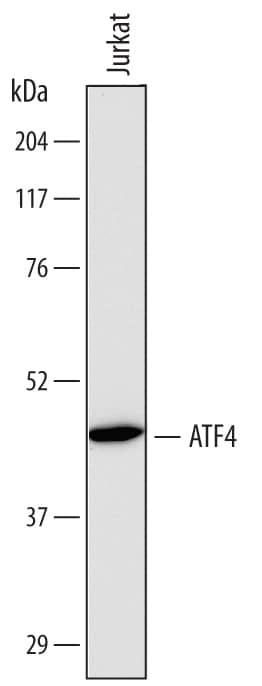Human ATF4 Antibody
R&D Systems, part of Bio-Techne | Catalog # MAB7218

Key Product Details
Species Reactivity
Validated:
Human
Cited:
Human
Applications
Validated:
Immunocytochemistry, Western Blot
Cited:
Western Blot
Label
Unconjugated
Antibody Source
Monoclonal Mouse IgG2A Clone # 739441
Product Specifications
Immunogen
E. coli-derived recombinant human ATF4
Met1-Pro351
Accession # P18848
Met1-Pro351
Accession # P18848
Specificity
Detects human ATF4 in direct ELISAs.
Clonality
Monoclonal
Host
Mouse
Isotype
IgG2A
Scientific Data Images for Human ATF4 Antibody
Detection of Human ATF4 by Western Blot.
Western blot shows lysates of Jurkat human acute T cell leukemia cell line. PVDF membrane was probed with 2 µg/mL of Mouse Anti-Human ATF4 Antigen Affinity-purified Monoclonal Antibody (Catalog # MAB7218) followed by HRP-conjugated Anti-Mouse IgG Secondary Antibody (Catalog # HAF007). A specific band was detected for ATF4 at approximately 47 kDa (as indicated). This experiment was conducted under reducing conditions and using Immunoblot Buffer Group 1.ATF4 in Jurkat Human Cell Line.
ATF4 was detected in immersion fixed Jurkat human acute T-cell leukemia cell line using Mouse Anti-Human ATF4 Monoclonal Antibody (Catalog # MAB7218) at 10 µg/mL for 3 hours at room temperature. Cells were stained using the NorthernLights™ 557-conjugated Anti-Mouse IgG Secondary Antibody (red, upper panel; Catalog # NL007) and counterstained with DAPI (blue, lower panel). Specific staining was localized to nuclei and cytoplasm. View our protocol for Fluorescent ICC Staining of Non-adherent Cells.Applications for Human ATF4 Antibody
Application
Recommended Usage
Immunocytochemistry
8-25 µg/mL
Sample: Immersion fixed Jurkat human acute T-cell leukemia cell line
Sample: Immersion fixed Jurkat human acute T-cell leukemia cell line
Western Blot
2 µg/mL
Sample: Jurkat human acute T cell leukemia cell line
Sample: Jurkat human acute T cell leukemia cell line
Reviewed Applications
Read 2 reviews rated 3 using MAB7218 in the following applications:
Formulation, Preparation, and Storage
Purification
Protein A or G purified from hybridoma culture supernatant
Reconstitution
Sterile PBS to a final concentration of 0.5 mg/mL. For liquid material, refer to CoA for concentration.
Formulation
Lyophilized from a 0.2 μm filtered solution in PBS with Trehalose. *Small pack size (SP) is supplied either lyophilized or as a 0.2 µm filtered solution in PBS.
Shipping
Lyophilized product is shipped at ambient temperature. Liquid small pack size (-SP) is shipped with polar packs. Upon receipt, store immediately at the temperature recommended below.
Stability & Storage
Use a manual defrost freezer and avoid repeated freeze-thaw cycles.
- 12 months from date of receipt, -20 to -70 °C as supplied.
- 1 month, 2 to 8 °C under sterile conditions after reconstitution.
- 6 months, -20 to -70 °C under sterile conditions after reconstitution.
Background: ATF4
Long Name
Activating Transcription Factor 4
Alternate Names
TAXREB67, TXREB
Gene Symbol
ATF4
UniProt
Additional ATF4 Products
Product Documents for Human ATF4 Antibody
Product Specific Notices for Human ATF4 Antibody
For research use only
